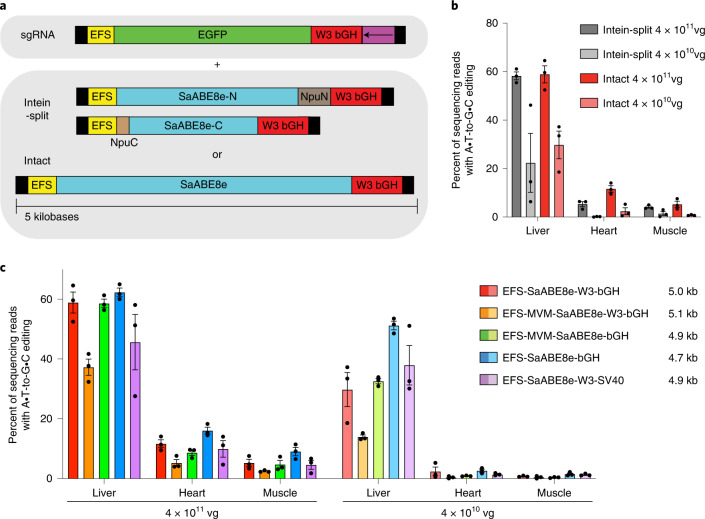Fig. 1. AAV constructs tested in vivo.
a, sgRNA targeting Pcsk9 W8 was delivered with EGFP in one AAV that was co-injected with either one or two additional AAVs encoding either an intact or intein-split SaABE8e, respectively. Thus a total of two AAVs were used to deliver the intact SaABE8e and sgRNA, and three AAVs were used to deliver the intein-split SaABE8e. Black boxes represent ITRs, EFS promoter is EF1a short, W3 is truncated WPRE, bGH is bovine growth hormone polyadenylation signal, the purple box is the U6 promoter-driven sgRNA cassette in the orientation indicated by the arrow, NpuN and NpuC split inteins from Nostoc punctiforme are shown in brown, and protein coding regions are indicated for EGFP and SaABE8e. b, In vivo editing efficiency from injection of AAV encoding intein-split and intact SaABE8e. The total dose of base editor AAV administered to each mouse is shown. c, Comparison of in vivo editing efficiency from injection of AAV9 encoding intact SaABE8e in five different AAV architectures when administered at the dose shown. In all cases, editor AAV dose was either 4 × 1011 vg or 4 × 1010 vg and sgRNA EGFP AAV dose was either 4 × 1011 vg or 4 × 1010 vg for a 1:1 ratio of base editor AAV to sgRNA AAV. The sizes of the delivered editor AAV constructs (including ITRs) are shown in the legend. C57BL/6J mice 6–7 weeks of age and 20–25 g were injected systemically by retro-orbital injection. Dots represent individual mice. Values and error bars represent mean ± s.e.m. of n = 3 different mice.

